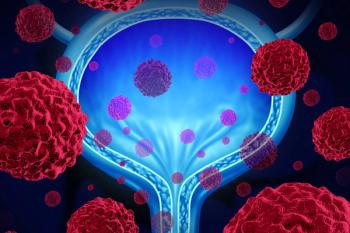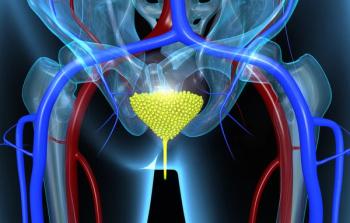
- ONCOLOGY Vol 13 No 7
- Volume 13
- Issue 7
UFT in Bladder Cancer
UFT, a compound containing uracil and tegafur (a prodrug of 5-fluorouracil) in a 4:1 molar ratio, has been used in Japan for the treatment of and as adjuvant chemotherapy for bladder cancer. In phase II studies, 300 to 600
ABSTRACT: UFT, a compound containing uracil and tegafur (a prodrug of 5-fluorouracil) in a 4:1 molar ratio, has been used in Japan for the treatment of and as adjuvant chemotherapy for bladder cancer. In phase II studies, 300 to 600 mg/day of UFT given orally for more than 4 weeks produced a 32% overall response rate, including a complete response rate of 19.0%. Toxicity was in general mild and reversible. Gastrointestinal toxicity affected 56% of patients receiving 600 mg/day and 24% of patients receiving 300 mg/day of UFT. A randomized, prospective trial was performed to determine whether long-term treatment with oral UFT (300 to 400 mg/day for 2 years) as adjuvant chemotherapy could prevent intravesical recurrence of superficial bladder cancer. Long-term UFT administration after transurethral resection, in fact, effectively prevented the recurrence of superficial bladder cancer, with acceptably low toxicity. These data suggest that UFT as a single agent is effective against bladder cancer, with mild toxicity when used properly.[ONCOLOGY 7(Suppl 3):112-115, 1999]
UFT is an oral antineoplastic drug combining uracil and tegafura prodrug of 5-fluorouracil (5-FU)in a 4:1 molar ratio. Uracil inhibits the degradation of 5-FU to inactive metabolites, resulting in increased plasma and tumor 5-FU concentrations.[1] UFT has been available commercially in Japan since 1984 and has been used in the treatment of and as adjuvant chemotherapy for bladder cancer, both as a single agent and in combination with other anticancer drugs. Results of phase I and phase II studies in Japan exploring the activity of UFT in the treatment of bladder cancer[2,3] are described herein.
Pooled Data
Pooled data from phase II trials of UFT in bladder cancer in Japan are shown in Table 1. In these trials, oral UFT was administered at 300 to 600 mg/day in two or three divided doses, without interruption, for more than 4 weeks.[4,5] There were 57 patients entered into these phase II studies, of whom 47 were evaluable for response. Among evaluable patients, 15 (32%) responded to UFT therapy, including nine with a complete response, for an overall response rate of 32%. Stable disease was noted in 55% (26/47), and disease progression occurred in 13% (6/47) of evaluable patients.
Of the 47 evaluable patients, 35 had superficial (stages Ta, T1) and 12 had advanced (stages T2 to T4) bladder cancer. Responses, including the nine complete responses, occurred in 11 of 35 patients with superficial bladder cancer. Four of 12 advanced bladder cancer patients responded to UFT, although none achieved complete response. The maximum response was obtained for approximately 8 to 9 weeks after starting therapy, and response duration ranged from 2 to 15 months in cases of complete response.
Toxicity criteria used in these phase II studies were slightly different from current criteria. The toxicity observed in the studies, nonetheless, was mild and reversible. Almost one half of the entered patients experienced mild toxicityprincipally gastrointestinal effects including anorexia, nausea and vomiting, diarrhea, and stomatitis. Hematologic toxicity was rare: only one case of mild leukopenia was reported.[4,5]
Shida et al have observed that UFT toxicity occurs in a dose-dependent manner (Table 2).[4] Toxicity was observed in 56% of patients receiving 600 mg/day of UFT, including 12% who discontinued UFT treatment. Toxicity was less frequent (24%) among patients receiving 300 mg/day of UFT.
Other fluorinated pyrimidines have activity as depicted in Table 3.
UFT as Adjuvant Chemotherapy
Based on this evidence of activity with UFT in superficial bladder cancer, we initiated a prospective study to determine the potential of long-term oral UFT in preventing intravesical recurrence of superficial bladder cancer.[6] The study schema is illustrated in Figure 1. A total of 112 patients with newly diagnosed superficial transitional cell carcinoma of the bladder (stages Ta, T1 and grades G1 or G2) were randomly assigned after complete tumor resection by transurethral endoscopic surgery to receive either UFT (300 to 400 mg/day po for 2 years) or no anticancer therapy (control group). UFT treatment was initiated within 14 days after surgery and was continued on a daily basis for 2 years.
Among the 112 patients entered into the study, seven were excluded from analysis, leaving 105 patients eligible for assessment. Patient characteristics and tumor features were similar between the two groups. After a median follow-up period of 24.5 months, the cancer recurrence rate, outlined in Table 4, was 25.7% in the UFT group and 43.3% in the control group (P = .015, log-rank test). The median disease-free interval (Figure 2) was significantly longer in the UFT group (790 days) than in the control group (508 days) (P < .05). Patients with relatively small or single tumors, in particular, had a significant difference (P = .03 and P = .012, respectively) in recurrence rate with UFT therapy vs the control group.
Toxicity associated with UFT administration was acceptably low. Eleven of 57 patients (19%) entered in the UFT arm experienced some toxicity, primarily consisting of gastrointestinal symptomsnausea, vomiting and diarrhea (7%), skin pigmentation (7%), mild liver dysfunction (3.5%), and mild thrombocytopenia (1.8%).
These results suggest that long-term UFT administration after transurethral resection can effectively prevent recurrence of superficial bladder cancer.
Fluorinated pyrimidines such as 5-FU and tegafur have been shown to be effective against bladder cancer, with mild toxicity when properly used.[7,8] UFT is a mixture of uracil and N-(2-tetrahydrofuryl)-5-fluorouracil (tegafur) in a 4:1 molar ratio. Uracil competitively inhibits dihydropyrimidine dehydrogenase (DPD), an enzyme that degrades 5-FU to an inactive form. Thus, UFT administration increases tumor concentration of 5-FU. When UFT was administered orally, the maximum 5-FU concentration in bladder cancer tissue was found to be 4 and 10 times higher than that occurring in normal bladder epithelium and peripheral blood, respectively.[9]
Our preliminary analysis by radiotherapypolymerase chain reaction of gene expression of DPD in bladder cancer tissue,[10] done in collaboration with Kathleen and Peter Daneneberg of the University of Southern California, showed that almost one half of tumors had high DPD expression, which, it has been suggested, reduces the effect of 5-FU. Thus, therapy for bladder cancer with UFT, which may inhibit the DPD enzyme, has potential value. In fact, in the pooled phase II data, oral UFT produced a greater response rate in bladder cancer patients than did oral 5-FU, as shown in Table 3.
Since intravesical recurrence of superficial bladder cancer (stages Ta, T1) after transurethral resection occurs frequently, effective adjuvant therapy to reduce the recurrence rate is greatly needed. Our theory that UFT might prevent recurrence of superficial bladder cancer with relatively low toxicity has been borne out by the results of the prospective, randomized trial described herein. Patients receiving UFT after transurethral resection for newly diagnosed bladder cancer showed a significantly lower recurrence rate than did untreated control patients. Stratification by grade, multiplicity, and tumor size indicated that the anticancer effect of UFT was particularly significant among patients with single small lesions less than 1 cm in diameter.
One of the basic concepts of systemic anticancer chemotherapy is to use the highest dose possible with side effects still tolerable by the patient to achieve maximum tumor response. In the case of adjuvant chemotherapy, however, the regimens might have as low a level of toxicity as possible to allow for the safe completion of long-term chemotherapy even after major surgery.
Based on accumulated evidence, oral UFT should be a useful approach to preventing recurrence of bladder cancer, although our data did not define dosage and duration recommendations for adjuvant therapy with this agent. These clarifications await further examination in formal clinical trials.
Oral UFT is an effective and relatively safe agent for the treatment of bladder cancer, yielding responses in almost one third of patients, especially those with superficial bladder cancer. In addition, long-term UFT administration after transurethral resection for superficial bladder cancer was shown to effectively prevent recurrence of disease, again with tolerable toxicity when used properly.
References:
1. Fujii S, Ikenaka K, Fukushima M, et al: Effect of coadministration of uracil or cytosine on the antitumor activity of clinical dose of 1-(2-tetrahydro-furyl)-5-fluorouracil and level of 5-fluorouracil in rodents. Gann 70:209-214, 1979.
2. Taguchi T, Furue H, Koyama Y, et al: Phase I study of UFT. Jpn J Cancer Chemotherapy 7:966-972, 1980.
3. Taguchi T: Experience with UFT in Japan. Oncology 11(suppl 10):30-34, 1997.
4. Shida K, Yamanaka H, Ito Y, et al: Phase II study of UFT for malignant tumors of urinary organs. Jpn J Cancer Chemotherapy 11:1307-1314, 1984.
5. Asahi T, Matumura Y, Ozaki Y, et al: Clinical effect of UFT on bladder cancer. Jpn J Cancer Chemotherapy 9:503-507, 1982.
6. Kubota Y, Hosaka M, Fukushima S, et al: Prophylactic oral UFT therapy for superficial bladder cancer. Cancer 71:1842-1845, 1993.
7. Nagamoto A, Kubota Y, Shuin T, et al: Phase II study of oral 5-FU tablet on bladder cancer. Jpn J Cancer Chemotherapy 16:845-850, 1989.
8. Omori H, Matumura Y, Yoshimoto J, et al: Phase II study of oral 5-FU tablet on bladder cancer. Jpn J Cancer Chemotherapy 15:3115-3120, 1988.
9. Takayama H, Konami T, Konishi T, et al: Studies on 5-FU concentration in serum and bladder tumor tissue after oral administration of UFT. Acta Urologica Japonica 32:1449-1453, 1986.
10. Lentz H-J, Leichman CG, Daneneberg K, et al: Thymidilate synthase expression in adenocarcinoma of the stomach: A predictor for primary tumor response and overall survival. J Clin Oncol 14:176-182, 1996.
Articles in this issue
over 26 years ago
Discussing Disease Progression and End-of-Life Decisionsover 26 years ago
New Genetic Mechanism Associated With Thyroid-Related Diseasesover 26 years ago
Beyond 5-Fluorouracilover 26 years ago
Nonsurgical Therapy Holds Promise for Basal Cell Carcinomaover 26 years ago
Photodynamic Therapy Effective for Swallowing Problemsover 26 years ago
Novel Gene Therapy to Clear Blood Clots in Leg ArteriesNewsletter
Stay up to date on recent advances in the multidisciplinary approach to cancer.

















































































